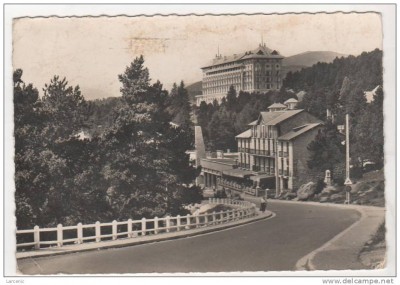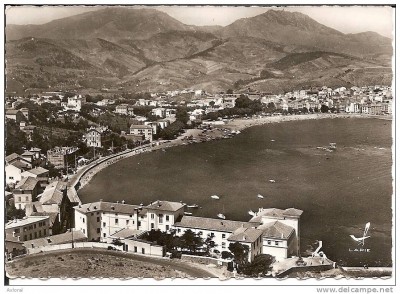Auteur : Mitrophane
Date de création : 05-03-2009
A pocket country
Translation by Mrs and Mr Florenci Salesas
Each morning, when we were having breakfast, my grandma told me about her dead loved ones. A list as endless as that of the foreign Legion commemoration service. By the very act of mentioning them, she caused them to be reborn within minutes.
I have dedicated a book to my Russian ancestors. The Bezsonovs and the Grigorievs. Now, I shall speak of the Catalan. The Montalats, the Brials, the Bauses, the Pujolses, the Bertranas. I’ll try my best to reanimate shadows of the lost words. The wilted words.
In the pages to come, I don’t intend to tell my life. It’s not that interesting. I was born a year after the end of the Algerian war. So far, luck has preserved me from ever having to go to war. Nobody has been killed around me. I’ve never felt an earthquake, seen a flood. I’ve never crossed forests on fire. I’ve never meet Voltaire at the Procope café. I’ve never taken a walk by the Yalta breakwater with the Doctor Chekhov. I‘ve never had a vermouth with Josep Pla at the Ampurdan hotel. I have only known the death of a language. A planned assassination, by thousands of murderers and accomplices.
By the time I was eleven, I had lived in six cities and two states and I had frequented five schools. In the midst of all of those moves, my grandparents’ house constituted a lighthouse, a rest. That house, for me, contained all that it meant to be Catalan; the very soul of catalanness. Behind an arbour of palm trees and wisterias, the house welcomed us at night with the barks of the neighbour’s dog. In winter, the stars shone more than in any other country. When we got there in summer, the frogs got very friendly with all of the cicadas of the region.
For many years, Nils has been the tiniest village of the Roussillon plain. Some inhabitants from the little neighbouring towns – who lived in metropolises of five hundred inhabitants’ such as Cànoes, Pontellà, Pollestres, or Vilanova de Raó – had rechristened it ‘the capital’.
Those imbeciles weren’t that far from the truth. During the defeat of 1940, the French government carried on a project to retire in the Grand-Hôtel of Perpignan. The President Lebrun installed himself at Tuïr. I don’t know if the fact that Nils is about ten kilometres from both places has escaped you...
We must recognize that etymology is against us. According to lluís Bassseda, Nils is derived from d’Anils, a catalanization of the Latin asinarium; the land of asses. The official French name of the town is Nyls. According to Joan Coromines and the editors of The Great Catalan Encilopeida, it should been written ‘Nils’ in Catalan, despite the local pronunciation being ‘Nyils’. Cinsequently, Lluís Basseda, Ramon Gual, and the leaders of the Bressola’s write ‘Nyils’. As all we know, this thing called Catalan isn’t a serious thing for people, and everybody has their own opinion about it...
The old folks always told me that Hannibal and his elephants crossed this place. Despite Uncle Claudi and the road engineers’ view, I think that the most beautiful panorama via which to discover Nils is the northern one. Past the slope of Cànoes and the range of Caraig appears the entire Roussillon plane. At the side on which the sun rises, the sea frolics with an almost chemical blue like disco lights. At the South, lies the Albera, green or blue depending on the season. At the side on which the sun sets, at the foot of Canigó, the two towers of Pontellà play at religious wars. The Sant Esteve tower bell competes with the republican tower of the old town hall.
Twenty years ago, at the entry of Nils, when the tower from the ‘fontinal’ project was erected, the ‘project’, was destroyed at the beginning of the eighties. It remembered the carcass of the Jardin des plantes’ diplodocus, in Paris. In Nils, we have more avenues than streets. Pollestres Avenue, Bages Avenue and Canta-rana Street follow the old walls. The stone of the country is tile. Nils seats itself on a cliff dominated by the Canta-rana, a ridiculous stream full of rushes and mud. It stinks all year round. The dogs and the big rats pooh in it. At night, the frogs and the toads get in movement while the rabbits come of their dens. From time to time, the stream remembers that it is a river and makes of with the car of an imprudent Parisian. In 1940, it grew so much that the water rose as far as the door of Uncle Claudi’s garage in the middle of the Main Street. If the timeless walls could talk, they would surely express themselves with the accent and in the words of Bernat Desclot. The visible bit of the wall on the street of the old cemetery street reminds me of the façades of Cuzco. The glory of the village is the templar church. All of the medievalists from around Catalonia go there. They assure that Nils once possessed a bell tower worthy of the one in Cuixà. The years, the wars and the idiocy of Men demolished it. The newer 17th century church never has interested anybody, with its modern plaster statues of Joan of Arc and Saint Joseph. Along the Pi path, where a bunch of cypresses have been rooted up to build residential areas, the kids still know Catalan. They amuse themselves by the mulberry tree of the school La bressola. Amidst the vineyards, on the way to Pollestres, the cemetery precedes the pond, dried up lout monks in the Middle Ages. Battery chickens are raised there.
The vinyards are called Moro, Resclosa, Teuleria, Clares, Mas Déu, Riberal, Andraus, Estany and Camps de Nils. The countrymen, conscious of the progress of agriculture, congratulate themselves on summer nights:
“Nowhere are there are vineyards like here. We have the best land in the country... No need to say it... We have quantity and quality...
Except for the view of the Canigó, which it shares with every other part of the plain, Nils hasn’t anything either beautiful or original. The minuscule avenues don’t drive you to any important monument. But, in this little bit of Catalonia, I learned the language my grandparents inherited from their people. Life here is sweet and tranquil. Eternity seems palpable behind the sly smile of the old countrymen.
(...)
Twenty five years ago there were one hundred habitants in Nils. They all they spoke Catalan except for a couple of old Murcians and some ten people who came from the interior of France. Now, the town has two hundred people and there remain twenty Catalans. I won’t see snail festivals in summer. The old men don’t play French bowls on Sundays on the landing of Canta-rana Street anymore. They’ve changed their address and now they are all at the cemetery in the middle of the vineyards.
In summer the street gossip disappeared, no more rows of chairs at the street. The countrymen spoke about the past and the grape seasons.
Now, the city council of Pontellà rents the square in front of the old templar church to boisterous city people who get drunk until three in teh morning to the sound of American crap. This is what is called progress. The language of Ramon Muntaner has evaporated like the fog on a summer morning.


Commentaires
I don't know! Waiting for an English publisher (and after making a properly proffreading, of course) We have to say them: hey, there are other languages existing out there! Make more translations, don't be so boring!
Jau hai gugent tai, Joan Daniel!
Its wonderful !! I doncs quan ho podrem comprar en inglès ?